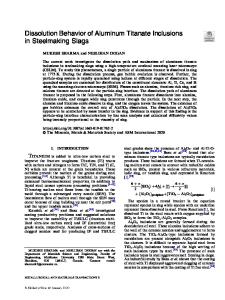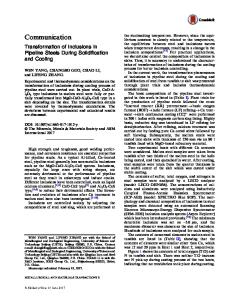Nonisothermal growth and dissolution of inclusions in liquid steels
- PDF / 143,151 Bytes
- 3 Pages / 612 x 792 pts (letter) Page_size
- 43 Downloads / 329 Views
of oxygen within the melt.[6] It is also assumed that the oxygen and aluminum concentrations in the weld metal do not change significantly during the growth of inclusions. This assumption would be valid where there is insufficient supersaturation for homogeneous nucleation and nucleation occurs at a finite number of heterogeneous nucleation sites. During welding, the atomic oxygen gas from the plasma dissolves continuously in the weld metal at a very rapid rate. As a result, the oxygen that is depleted due to formation of the inclusions is replenished by the dissolution of oxygen in the weld metal from the plasma. Because the atomic oxygen is much more reactive than the diatomic oxygen, and the weld pool is well mixed, the concentration of dissolved oxygen in the weld pool is determined by the thermodynamic equilibrium between the atomic oxygen gas in the plasma and the dissolved oxygen in the liquid weld metal. The concentrations of the elements at the interface between the inclusions and the liquid steel are needed to calculate the diffusion rates at various temperatures. The method of calculating interfacial concentrations at a constant temperature is indicated in References 3 and 4. After the interfacial concentrations are known, a dimensionless concentration of nonmetallic elements, c*, may be defined as[7] c* ⫽ (cbQ ⫺ cQi )/(cPQ ⫺ cQi )
where cQ is the concentration of nonmetallic element Q; and the subscripts p, b, and i refer to the inclusion particle, bulk liquid metal, and inclusion/steel interface, respectively. Because the concentration of Q in the inclusion particle, cQP is always higher than that at the interface, ciQ, the sign of c* depends on the relative values of cQb and cQi . When the temperature is lower than the equilibrium temperature for the coexistence of the inclusion and the liquid steel, cQb is higher than ciQ and, as a result, c* is positive. In this situation, the element Q is transported from the bulk liquid toward the interface resulting in inclusion growth. Equation [2] is applied to calculate the growth behavior in this case.[7] ri⫹l ⫺ ri ⫽
12DQc* 2 1t
⌬t
METALLURGICAL AND MATERIALS TRANSACTIONS B
[2]
When the temperature is higher than the equilibrium temperature for the coexistence of inclusion and liquid steel, c* is negative and the element Q diffuses from the interface into the bulk liquid. The dissolution rate of the inclusion is given by.[8] ri⫹1 ⫺ ri ⫽ c* c
DQ DQ ⫹ d ⌬t ri B pt
[3]
In Eqs. [2] and [3], ri and ri⫹1 are the inclusion radii before and after the ith time-step, respectively; ⌬t is the time-step; and DQ is the temperature-dependent diffusion coefficient of Q in liquid steel calculated by DQ ⫽ D0Q ⭈ e ⫺(E/RT)
T. HONG, formerly Graduate Student with the Department of Materials Science and Engineering, The Pennsylvania State University, is Senior Project Engineer with the Technical Center, Caterpillar Inc., Peoria, IL 61656. T. DEBROY, Professor, is with the Department of Materials Science and Engineering, The Pennsylvania State University, University Park,
Data Loading...











